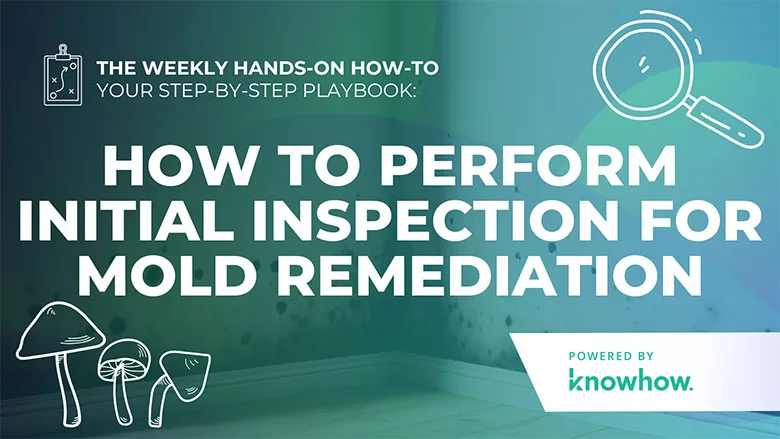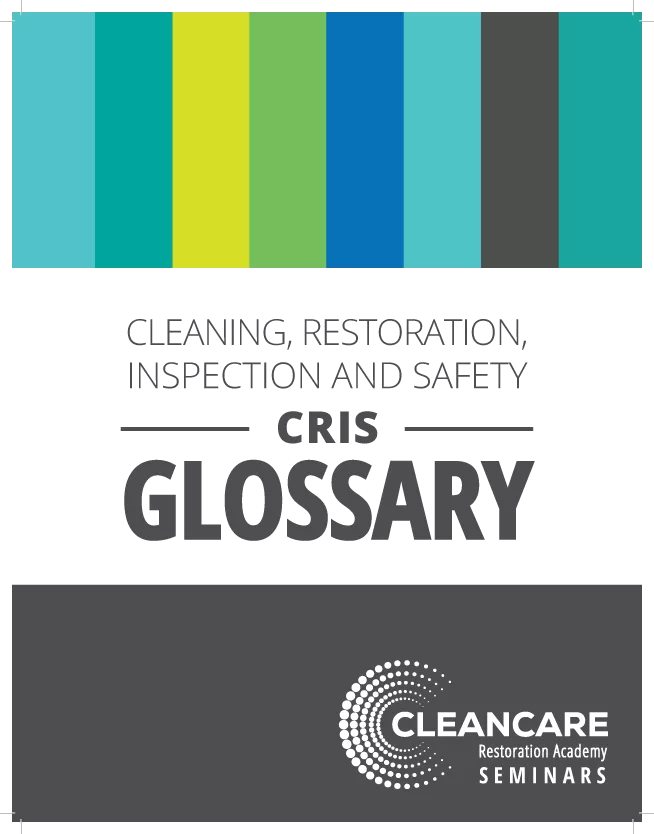Weekly Hands-on How-To powered by KnowHow
How to Perform Initial Inspection for Mold Remediation

Mold likes to play hide-and-seek, and it hides where you least expect it, silently infiltrating homes and causing unseen damage long before it's detected. As a restorer, your role isn't just to treat mold—it's to anticipate its location and find it. But unlike the popular childhood game, calling out 'Marco' won't get you a 'Polo' – you must actively seek out the mold yourself.
So, in this weekly how-to (and second edition of Mold May!), powered by KnowHow, we will equip you with the necessary tactics to uncover mold (no matter how sneaky it is) and develop a plan to begin remediation. From initiating contact with a concerned homeowner to the detailed preparation for an Industrial Hygienist, we cover all the bases.
Let’s explore the best tactics for catching the so-called “fun guy” wreaking havoc on your clients' homes.
Step 1: Confirm Your Appointment
Begin by confirming your appointment with the homeowner once you receive the file. This initial touch ensures everyone is ready for your visit.
Step 2: Arrive on Site and Begin Documenting
Upon arrival, document the scene by photographing the home’s exterior. This step is typically required by insurance carriers.
Step 3: Introduce Yourself and Gather Initial Information
Begin by greeting the homeowner politely to build rapport and establish trust. Clearly explain your role and the purpose of your visit. Then, ask questions that help you understand the scope of the issue and the client's perspective, such as:
- “When did you first notice the problem?” This helps identify the issue's timeline, indicating whether it's a recent or longstanding problem.
- “Do you know the cause of the damage?” This question can reveal critical insights that the homeowner might have observed firsthand, helping you confirm or narrow down potential sources of moisture.
- “Have there been any other recent losses or renovations in the neighborhood/area?” This question provides context about the broader environment, like water main issues or nearby construction, which could impact the property.
After gathering initial insights, ask the homeowner to guide you where microbial growth is suspected. This will allow you to verify their information firsthand and formulate an accurate assessment.

Step 4: Suit Up with PPE
Donning personal protective equipment (PPE) before inspecting up close is a critical safety step. Mold spores and other contaminants can pose significant health risks.
Proper PPE typically includes gloves, goggles, coveralls, and a respirator, depending on the severity of the contamination. For a refresher on donning and doffing PPE, refer to this KnowHow template.
Step 5: Document Everything
Take photos and a video walkthrough to capture comprehensive visuals of the affected areas. Start in each corner of the room to photograph from the top down, ensuring ceilings and flooring are fully covered. Pay attention to any surfaces or items that may require repair post-mold remediation and document any valuable or already damaged items.
Step 6: Inspect and Sketch Out the Area
Carefully inspect and sketch the area, noting:
- Cause of Loss (COL)
- Any necessary professional services needed (plumber, electrician)
- Items that may need to be removed for access (cabinets, countertops, etc.)
- Measurements of the room, noting length, width, and height
- Determine if the damage extends beyond the immediate area

Step 7: Create Your Tentative Scope Sheet
Begin drafting a tentative scope sheet by measuring the room's dimensions to outline the area requiring remediation. Identify which materials and structures need removal, noting their estimated square or linear footage.
This list typically includes:
- Flooring
- Baseboards
- Drywall
- Countertops
- Underlayment
- Any necessary detachment of plumbing items.
Next, estimate the work required on the remaining structures and identify the equipment needed for remediation, such as dehumidifiers, air scrubbers, and HEPA vacuums. Finally, specify the PPE requirements and outline any content manipulation needed to handle contaminated materials properly.
Step 8: Properly Remove and Clean PPE
After inspection, properly remove and discard your PPE. Clean your respirator thoroughly to ensure it is sanitized and ready for future use.
Step 9: Prepare for an Industrial Hygienist
Explain to the homeowner the critical role of an Industrial Hygienist in pre and post-testing and set up the appointment at a time that works for them.
Industrial Hygienists are essential for accurately identifying the type and extent of mold infestation and assessing potential health risks. They will thoroughly evaluate the mold issue and provide a detailed report outlining necessary remediation steps.
Step 10: Conclude Your Visit
Thank the homeowner for cooperating, and discuss the next steps. Provide a timeline for receiving the Hygienist's written report, preparing the estimate, and starting the remediation work, ensuring the homeowner knows what to expect moving forward.
Step 11: Prepare Initial Estimate
Use your inspection data to write a comprehensive estimate detailing the work required. This estimate will be finalized once the official protocol from the Industrial Hygienist is received, allowing you to adjust the scope and cost accordingly.
Step 12: Submit for Approval
Submit your comprehensive estimate to the insurance carrier for approval, ensuring all documentation is complete. Photos and other documents can be uploaded before leaving the site or once you return to the office.
Master More Than Just Mold Remediation with KnowHow
Successful mold remediation builds trust with your clients, helps protect their properties, and builds your brand as the “town saviors.” With KnowHow by your side, your team will have the tools and knowledge to deliver this high-quality work consistently.
KnowHow offers powerful tools that streamline your operations, from onboarding new hires to providing instant on-the-job support. KnowHow connects your teams to comprehensive training materials, step-by-step processes, and industry expertise (all based on your SOPs) that empower your team to handle every challenge with confidence.
Visit tryknowhow.com and discover how KnowHow can elevate your team's performance, knowledge, and efficiency.
Looking for a reprint of this article?
From high-res PDFs to custom plaques, order your copy today!






